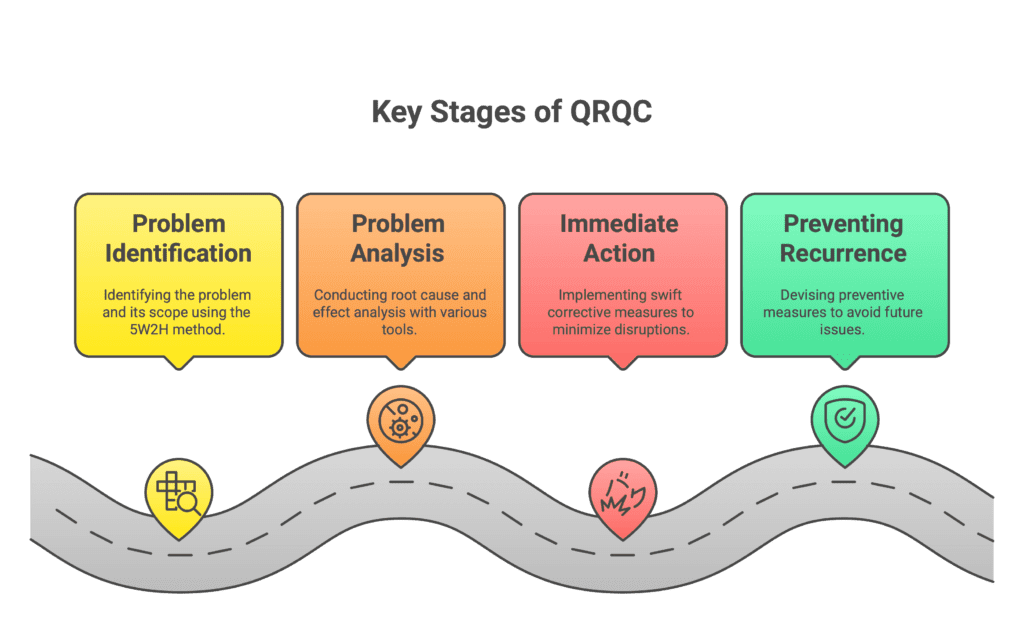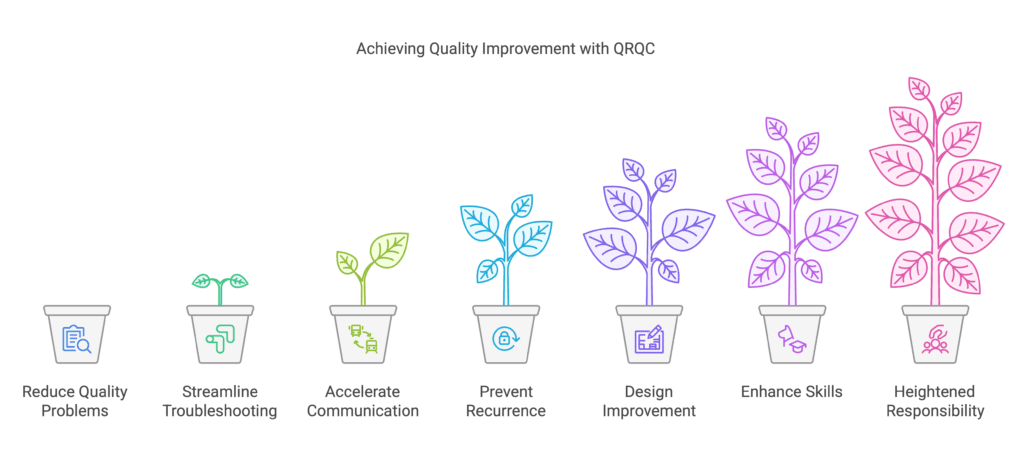Quality problems solving in production processes is extremely important for the success of the company.
The QRQC method serves as an effective tool for swiftly identifying, analyzing, and eliminating quality issues. In this article, we will delve deeper into this method and explore its application in enhancing production process efficiency.
Introduction to QRQC method
QRQC, or Quick Response Quality Control, is a systematic problem-solving approach tailored to promptly address quality issues in production. Its primary objective is to minimize response time and enhance production quality. Below, we outline its key stages.
Step 1- Problem identification
The initial phase involves precisely identifying the problem and determining its scope. Understanding the problem’s impact on production quality and efficiency is paramount. The 5W2H method is commonly employed for this purpose, offering detailed insights into problem definition and scope.
Further elaboration on this method can be found in a dedicated article.
Stage 2 – Problem analysis
After identifying the problem, the next step involves conducting a root cause and effect analysis. During this stage, a variety of tools and techniques are utilized to delve deeper into the underlying causes of the issue. Some examples: the Ishikawa diagram, the 5xWhy analysis or the Pareto diagram.
Stage 3 – Immediate action
An essential aspect of QRQC is the prompt implementation of corrective measures. During this stage, specific actions are swiftly taken to address and rectify the identified problem. The emphasis lies on expedited yet effective actions aimed at minimizing disruptions to the production process.
Stage 4 – Preventing recurrence
In this phase, a thorough analysis of the problem’s root causes is conducted, and preventive measures are devised to eradicate these underlying issues. It’s imperative to closely monitor the process to ensure that the problem does not resurface.
This approach aligns with the expectations of our customers in the automotive industry and was a driving force behind the updates to the IATF problem-solving requirements outlined in the sanctioned interpretations.

How QRQC Relates to the Deming Cycle”
The initial problem-solving steps of QRQC align closely with those found in the 8D Report or A3 Report, making it one of the three most widely used problem-solving methods, both within and outside the automotive industry
Hence, it’s no surprise that, akin to these techniques, QRQC is closely intertwined with the Deming cycle, also known as the PDCA (Plan-Do-Check-Act) cycle or continuous improvement cycle. This cycle serves as the cornerstone of the quality management system, facilitating ongoing process enhancements and organizational excellence.
For deeper insights, I recommend exploring the insightful book ‘4 Days with Dr. Deming,’ the review of which can be found here.
We can elucidate the connections between QRQC and the Deming cycle concerning the individual stages of the cycle.
Plan
During the planning stage, the focus is on problem identification, goal setting, and delineating the scope of actions to resolve the issue, along with devising a strategy and action plan. This parallels the first stage of the Deming cycle, which involves goal setting and activity planning.
Do
The execution stage entails carrying out planned activities to address the quality problem, emphasizing effective action implementation to prevent problem recurrence. This mirrors the second stage of the Deming cycle, which advocates for action implementation as per the agreed plan.
Check
The checking phase involves actively monitoring the effectiveness of actions and assessing whether we have adequately resolved the problem. This includes analyzing results, comparing them with expectations, and evaluating whether we have achieved our goals.
Act
This phase entails implementing preventive actions, involving specific measures to address the problem’s root causes. The operation of QRQC aligns with the fourth stage of the Deming cycle, which entails implementing changes to establish new standards and prevent problem recurrence.
Both approaches prioritize continuous improvement and quality enhancement, with QRQC leveraging the Deming cycle as a reference framework for problem identification, action planning, execution, performance monitoring, and preventive action to address specific issues.
How QRQC utilizes the San Gen Shugi principle?
QRQC adopts San Gen Shugi, a cornerstone of Japanese organizational culture and a quality management tool, which encompasses the following three principles:
Genba – “Place”
Genba emphasizes the need to directly investigate the site where the problem occurs, analyzing real-time data and information. It’s about gaining an in-depth understanding of the situation. For instance, at the Tychy Fiat plant, the plant director would often inquire if the problem solver had visited the Genba.
Genbutsu – “Object”
Genbutsu stresses the importance of focusing on specific situations and places where the problem manifests. It entails directly examining the parts, machinery, processes, or areas where the issue arose to identify and comprehend its causes.
Genjitsu – “Reality”
Genjitsu underscores the importance of grounding problem-solving efforts in reality and facts. It relies on data, evidence, and observations to inform decision-making and implement effective corrective actions.
Benefits of Utilizing QRQC
Implementing QRQC yields numerous benefits and positive outcomes, including:
– Substantial reduction in the occurrence of quality problems by pinpointing and eliminating their root causes, leading to reduced losses and costs.
– Streamlined and effective troubleshooting processes.
– Accelerated and enhanced communication of problem-related information and effective resolution strategies, minimizing operational downtime and resource wastage.
– Prevention of problem recurrence through the introduction of preventive measures, often by establishing new standards (equivalent to step D7 in the 8D Report).
– Enhanced design improvement based on past error data, fostering continuous process and product enhancement.
– Enhanced problem-solving skills among staff through training and collaborative teamwork within QRQC framework.
– Heightened sense of responsibility among production team members by involving them in the identification, analysis, and resolution of quality issues.

QRQC has demonstrated its effectiveness across various industries, notably in automotive and electronics, where it has significantly reduced complaint rates and improved product quality.
Challenges in QRQC Implementation
While implementing QRQC, several challenges may arise, such as incomplete team involvement or difficulties in identifying root causes. However, adhering to best practices like effective team communication, regular progress reviews, and continuous process improvement can help overcome these challenges.
In summary, QRQC’s structured approach, focusing on swift problem resolution and elimination, contributes to enhancing company quality, efficiency, and overall performance.
Dariusz Kowalczyk


